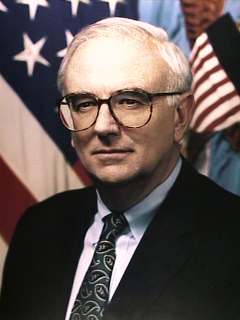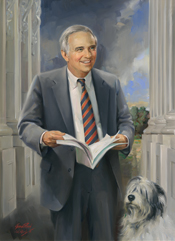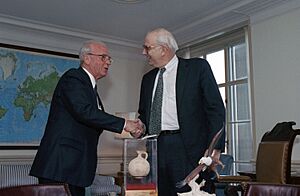Les Aspin facts for kids
Quick facts for kids
Les Aspin
|
|
|---|---|
 |
|
| Chair of the President's Intelligence Advisory Board | |
| In office May 26, 1994 – May 21, 1995 |
|
| President | Bill Clinton |
| Preceded by | William Crowe |
| Succeeded by | Warren Rudman (acting) |
| 18th United States Secretary of Defense | |
| In office January 21, 1993 – February 3, 1994 |
|
| President | Bill Clinton |
| Deputy | William Perry |
| Preceded by | Dick Cheney |
| Succeeded by | William Perry |
| Chair of the House Armed Services Committee | |
| In office January 3, 1985 – January 20, 1993 |
|
| Preceded by | Melvin Price |
| Succeeded by | Ron Dellums |
| Member of the U.S. House of Representatives from Wisconsin's 1st district |
|
| In office January 3, 1971 – January 20, 1993 |
|
| Preceded by | Henry Schadeberg |
| Succeeded by | Peter Barca |
| Personal details | |
| Born |
Leslie Aspin Jr.
July 21, 1938 Milwaukee, Wisconsin, U.S. |
| Died | May 21, 1995 (aged 56) Washington, D.C., U.S. |
| Political party | Democratic |
| Spouse |
Maureen Shea
(m. 1969; div. 1979) |
| Education | Yale University (BA) University of Oxford (MPhil) Massachusetts Institute of Technology (PhD) |
| Military service | |
| Branch/service | United States Army |
| Years of service | 1966–1968 |
| Rank | Captain |
Leslie "Les" Aspin Jr. (born July 21, 1938 – died May 21, 1995) was an American politician. He was a member of the Democratic Party. Aspin served as a U.S. Representative for Wisconsin from 1971 to 1993. Later, he became the 18th United States Secretary of Defense under President Bill Clinton from 1993 to 1994.
In Congress, Les Aspin was known for being smart and thoughtful. He often took a balanced approach on tough issues. For example, he supported some of President Ronald Reagan's defense plans. These included the MX missile and aid to the Nicaraguan Contras. However, he was against other projects like the B-2 bomber. He also played a key role in getting the House to support military action against Iraq in 1991. This was after Iraq invaded Kuwait.
As Secretary of Defense, Aspin faced many challenges. These included deciding how the military would be used in places like Somalia and Bosnia. He also worked on reducing the military's size after the Cold War. His time as Secretary ended after U.S. soldiers died in Somalia due to a lack of military support.
| Top - 0-9 A B C D E F G H I J K L M N O P Q R S T U V W X Y Z |
Early Life and Education
Les Aspin was born in Milwaukee, Wisconsin. He went to Shorewood High School. After high school, he attended Yale University. He graduated in 1960 with a degree in history.
Aspin continued his studies at the University of Oxford. There, he earned a degree in economics in 1962. He then received his PhD in economics from the Massachusetts Institute of Technology in 1966.
Aspin met his wife, Maureen Shea, in Saigon during the Vietnam War. They married in 1969 but later divorced in 1979. They did not have any children.
Before becoming a politician, Aspin worked for U.S. Senator William Proxmire. He also served in the United States Army from 1966 to 1968. During this time, he worked at the Pentagon as a systems analyst. Before being elected to Congress, he taught economics at Marquette University.
Serving in Congress
Aspin first ran for Congress in 1970. He campaigned as a "peace candidate," meaning he was against the Vietnam War. He won a very close primary election and then defeated the current representative, Henry Schadeberg.
Les Aspin served in the United States House of Representatives from January 3, 1971, to January 20, 1993. He quickly became an expert on defense matters. Early in his career, he often spoke out about problems he saw in the armed forces. For example, in 1973, he criticized the Air Force for a plan to buy beagle puppies for gas tests. His public campaign led to many letters of protest to the Defense Department.
By 1985, Aspin became the chairman of the House Armed Services Committee. This showed he was a respected leader in defense. However, his support for some of President Ronald Reagan's policies caused debate among other Democrats. These policies included the MX missile and aid to the Nicaraguan Contras.
Despite some disagreements, Aspin remained a key figure. In 1991, he supported President George H.W. Bush's decision to use military force against Iraq. His prediction that the U.S. would win quickly with few losses boosted his reputation as a military expert.
Secretary of Defense
Becoming Secretary of Defense

Les Aspin advised Bill Clinton on defense during the 1992 presidential campaign. Since Clinton had little military background, choosing a respected defense expert like Aspin was a good idea. Aspin's views were well known. He thought the Strategic Defense Initiative was not needed. He also favored a smaller Navy and fewer U.S. troops in Europe.
These ideas, along with expected budget cuts, worried some military leaders. However, defense companies liked Aspin's choice. They believed he would help keep the defense industry strong. Even with many questions, the Senate easily approved Aspin for the job.
New Challenges and Military Review
When Aspin took office, he talked about new dangers after the Cold War. These included the risk of nuclear weapons spreading. He also noted the rise of local conflicts and the impact of the U.S. economy on national security. It was clear the Pentagon was entering a time of big changes. Aspin seemed like the right person to lead these changes.
However, Aspin faced problems from the start. He had heart issues and was hospitalized twice in early 1993. He also had to deal with tough social issues, like the role of women in combat.
Aspin's biggest task was creating the defense budget for 1994. This was complicated because President Clinton promised to cut military spending. Aspin also ordered a "bottom-up review" of the military. This review looked at how the military should be structured after the Cold War. It aimed to cut costs while keeping the U.S. strong.
The review suggested a smaller military that could still fight two major regional conflicts at once. This included fewer Army divisions and Navy ships. It also called for better equipment and more transport capacity. The review's findings helped shape the 1994 defense budget. Aspin proposed a budget of $263.4 billion, which was about $12 billion less than before.
Aspin also announced the end of the "Star Wars" program (Strategic Defense Initiative). He renamed it the Ballistic Missile Defense Organization. This showed a shift in focus to missile defense. Like his predecessors, Aspin also had to decide on closing military bases. He proposed closing 31 large bases to save over $3 billion a year.
Global Issues and Decisions
While working on the budget, Aspin also dealt with many global problems. In NATO, he promoted the "Partnership for Peace" program. This program aimed to bring NATO and non-NATO countries together for military training and peacekeeping.
The situation in Haiti was another challenge. The elected president, Jean-Bertrand Aristide, had been removed from power. The U.S. tried to pressure the military government to step down. In October 1993, a U.S. ship carrying troops turned back from Haiti. This happened after it was met by an angry crowd. Some criticized Aspin for this outcome.
North Korea also caused concern. It was suspected of developing nuclear weapons. North Korea refused inspections of its nuclear sites. Aspin rejected their demand to cancel a joint training exercise with South Korea. He also announced that the U.S. would not withdraw troops from the Korean Peninsula.
In the Persian Gulf, Iraq remained a problem. In June 1993, U.S. Navy ships fired missiles at Iraq's intelligence headquarters. This was in response to a plot to assassinate former President Bush. Aspin called it a "wake up call" for Saddam Hussein.
The civil war in Bosnia also demanded attention. Aspin did not favor sending ground troops. The administration decided on airdrops of humanitarian aid instead.
Somalia became Aspin's biggest challenge. A civil war had been going on since 1991. The U.S. first sent aid and then troops to help. In December 1992, the U.S. joined a Unified Task Force (UNITAF). This force aimed to bring security and food relief. UNITAF helped restore order and distribute food.
In March 1993, the United Nations Operation in Somalia II began. The U.S. reduced its troops but later added Army Rangers. Aspin explained that U.S. troops would stay until order was restored in Mogadishu. They also aimed to disarm rival groups and establish police forces. The U.S. increased military efforts against a Somali warlord, Mohamed Farrah Aidid. The deaths of U.S. soldiers in Somalia due to lack of support led to Aspin's resignation.
Later Life and Legacy
After leaving his role as Secretary of Defense, Les Aspin joined Marquette University. He taught in their international affairs program. He also became chairman of the President's Foreign Intelligence Advisory Board. In March 1995, he began work on a study about the Intelligence Community.
Aspin had a heart condition that worsened in his later years. He had a stroke in May 1995, which led to his death on May 21, 1995, in Washington, D.C.. He was buried in Brookfield.
Marquette University honored him by naming its Les Aspin Center for Government after him.
Images for kids





